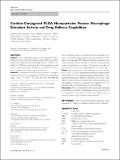| dc.contributor.author | Tukulula, Matshawandile | |
| dc.contributor.author | Hayeshi, Rose | |
| dc.contributor.author | Fonteh, Pascaline | |
| dc.contributor.author | Meyer, Debra | |
| dc.contributor.author | Ndamase, Abongile | |
| dc.contributor.author | Madziva, Michael T. | |
| dc.contributor.author | Khumalo, Vincent | |
| dc.contributor.author | Lubuschagne, Philip | |
| dc.contributor.author | Naicker, Brendon | |
| dc.contributor.author | Swai, Hulda | |
| dc.contributor.author | Dube, Admire | |
| dc.date.accessioned | 2019-10-18T07:52:58Z | |
| dc.date.available | 2019-10-18T07:52:58Z | |
| dc.date.issued | 2015-03-28 | |
| dc.identifier.uri | DOI 10.1007/s11095-015-1655-9 | |
| dc.identifier.uri | http://dspace.nm-aist.ac.tz/handle/123456789/504 | |
| dc.description | Research Article published by Springer | en_US |
| dc.description.abstract | Purpose There is significant interest in the application of nanoparticles
to deliver immunostimulatory signals to cells.We hypothesized
that curdlan (immune stimulating polymer) could be conjugated
to PLGA and nanoparticles from this copolymer would
possess immunostimulatory activity, be non-cytotoxic and function
as an effective sustained drug release system.
Methods Carbodiimide chemistry was employed to conjugate
curdlan to PLGA. The conjugate (C-PLGA) was characterized
using 1H and 13C NMR, FTIR, DSC and TGA. Nanoparticles were synthesized using an emulsion-solvent evaporation technique.
Immunostimulatory activity was characterized in THP-1
derived macrophages. MTTassay and real-time impedance measurements
were used to characterize polymer and nanoparticle
toxicity and uptake in macrophages. Drug delivery capability was
assessed across Caco-2 cells using rifampicin as a model drug.
Results Spectral characterization confirmed successful synthesis
of C-PLGA. C-PLGA nanoparticles enhanced phosphorylated
ERK production in macrophages indicating cell stimulation. Nanoparticles
provided slow release of rifampicin across Caco-2 cells.
Polymers but not nanoparticles altered the adhesion profiles of the
macrophages. Impedance measurements suggested Ca2+ dependent
uptake of nanoparticles by the macrophages.
Conclusions PLGA nanoparticles with macrophage stimulating
and sustained drug delivery capabilities have been prepared. These
nanoparticles can be used to stimulate macrophages and concurrently
deliver drug in infectious disease therapy. | en_US |
| dc.language.iso | en | en_US |
| dc.publisher | Springer | en_US |
| dc.subject | immunostimulantnanoparticles | en_US |
| dc.subject | real-time impedance measurements | en_US |
| dc.subject | PLGA nanoparticles | en_US |
| dc.title | Curdlan-Conjugated PLGA Nanoparticles Possess Macrophage Stimulant Activity and Drug Delivery Capabilities | en_US |
| dc.type | Article | en_US |

